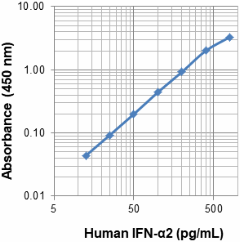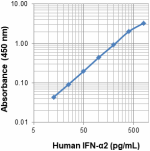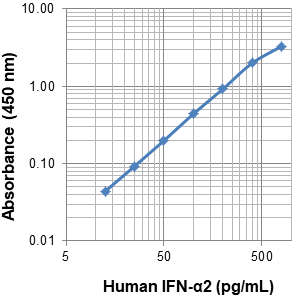- Clone
- BL25372 (See other available formats)
- Regulatory Status
- RUO
- Other Names
- IFN-alpha 2B, IFN-alphaA, IFNA2, IFNA2B, Interferon Alpha 2
- Isotype
- Mouse IgG1
- Ave. Rating
- Submit a Review
- Product Citations
- publications

-

Coating Buffer B, M4509E12 at 4 µg/mL as capture antibody, Blocked Assay Diluent A (ADA) 1 hr, lyophilized standard 2 hr in Assay Buffer G 50:50 with Matrix A run 12.5 – 800 pg/mL, BL25372 (MT-2) at 0.1 µg/mL 1 hr for detection in ADA, 0.8 µg/mL Avidin HRP in ADA 30 min, TMB F 15 min (in house 76335).
| Cat # | Size | Price | Quantity Check Availability | Save | ||
|---|---|---|---|---|---|---|
| 537204 | 100 µg | $265 | ||||
Interferons are divided into type I, II, and III. Type I IFNs (IFN-α and IFN-β) are most abundant in number, distribution, and expression. Also, they are highly conserved among mammals in both structure and function. IFN-α2 has been used in the treatment of cancer such as bladder cancer, hepatocellular carcinoma, and leukemia. IFN-α2 augments the suppressed immune functions in patients with head and neck squamous cell carcinoma (HNSCC). IFN-α2 initiated T and NK cell mediated cytotoxicity of tumor cells through IFNγ dependent and independent mechanisms. IFN-α2 enhances suppressed T cell cytotoxicity by stimulation of the perforin-granzyme B system (IFNγ dependent). Also, IFN-α2 induces the expression of perforin-granzyme B in NK cells (NK mediated cytotoxicity, IFNγ independent). In a preliminary study, IFN-α2 appears to be an effective immunostimulator and impacts the clinical outcome in tongue squamous cell carcinoma patients. IFN-α had been used in the treatment of chronic hepatitis C (CHC); nevertheless, IFN-α is relatively unstable and requires frequent parenteral administration. Pegylation of IFN-α, polyethylene glycol (PEG)-IFN-α, reduces in vitro activity but increase the stability and plasma half-life of IFN-α; therefore, PEG-IFN-α has replaced IFN-α in CHC treatment.
Product DetailsProduct Details
- Verified Reactivity
- Human
- Antibody Type
- Monoclonal
- Host Species
- Mouse
- Immunogen
- Recombinant protein
- Formulation
- Phosphate-buffered solution, pH 7.2, containing 0.09% sodium azide.
- Preparation
- The antibody was purified by affinity chromatography.
- Concentration
- 0.5 mg/ml
- Storage & Handling
- The antibody solution should be stored undiluted between 2°C and 8°C. Do not freeze.
- Application
-
ELISA Detection - Quality tested
- Recommended Usage
-
Each lot of this antibody is quality control tested by ELISA assay. For ELISA Detection applications, a concentration range of 0.05 - 0.4 µg/mL is recommended. To obtain a linear standard curve, serial dilutions of IFN-α2 recombinant protein ranging from 12.5 to 800 pg/mL is recommended for each ELISA plate. It is recommended that the reagent be titrated for optimal performance for each application.
- Application Notes
-
The biotinylated BL25372 antibody is useful as the detection antibody in a sandwich ELISA assay, when used in conjunction with the pure M4509E12 antibody (Cat. No. 537102) as the capture antibody and Recombinant Human IFN-a2 (ELISA Std.) (Cat. No. 592709)
- RRID
-
AB_2783347 (BioLegend Cat. No. 537204)
Antigen Details
- Distribution
-
IFN-α is ubiquitously expressed.
- Function
- IFN-α stimulates cytotoxic T lymphocytes and natural killer cell function. IFN-α has immunomodulatory and antiviral properties. IFNα2a induces CXCL10 in human microvascular endothelial cells and pulmonary artery smooth muscle cells. It is induced by viral infection.
- Interaction
- A variety of cells express the IFNα receptor (IFNAR).
- Ligand/Receptor
- IFNAR complex has two components, IFNAR1 and IFNAR2.
- Biology Area
- Immunology, Innate Immunity
- Molecular Family
- Cytokines/Chemokines
- Antigen References
-
- Bose A and Baral R. 2007. Immunol Lett. 108:68.
- Zhao W, et al. 2008. J Immunol. 180:5483.
- Badiger R, et al. 2012. Plos One. 7:e46779.
- Aghemo A, et al. 2010. Nat Rev Gastroenterol Hepatol. 7:485.
- Becker-Merok A, et al. 2013. Lupus. 22:155.
- Mukherjee KK, et al. 2012. Indian J Med Res. 136:54.
- Gene ID
- 3440 View all products for this Gene ID
- UniProt
- View information about IFN-alpha2 on UniProt.org
Related FAQs
- How many biotin molecules are per antibody structure?
- We don't routinely measure the number of biotins with our antibody products but the number of biotin molecules range from 3-6 molecules per antibody.
Other Formats
View All IFN-α2 Reagents Request Custom Conjugation| Description | Clone | Applications |
|---|---|---|
| Biotin anti-human IFN-α2 | BL25372 | ELISA Detection |
Customers Also Purchased


Compare Data Across All Formats
This data display is provided for general comparisons between formats.
Your actual data may vary due to variations in samples, target cells, instruments and their settings, staining conditions, and other factors.
If you need assistance with selecting the best format contact our expert technical support team.
-
Biotin anti-human IFN-α2

Coating Buffer B, M4509E12 at 4 µg/mL as capture antibody, B...
 Login/Register
Login/Register 













Follow Us